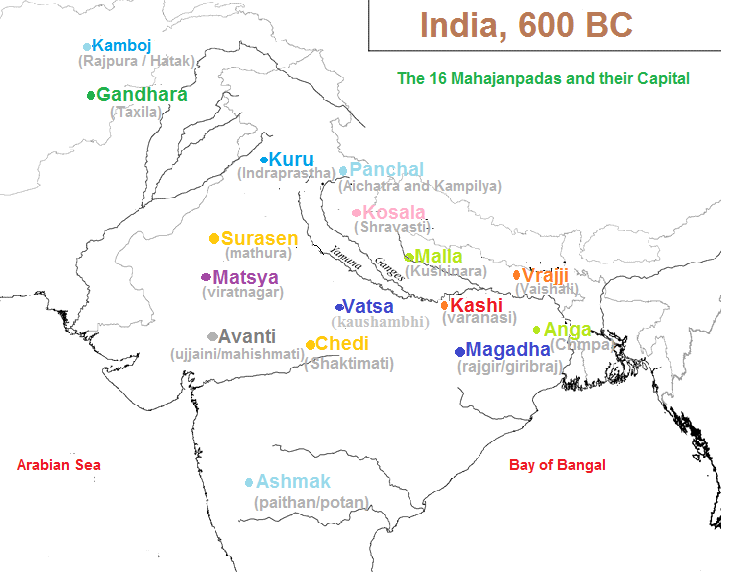In the sixth century BC, before the birth of Buddha, India was divided into 16 Mahajanapadas. Mahajanapadas were called administrative units in ancient India. The Mahajanapada extended from Afghanistan to Bihar in the north and from the Hindukush mountain to the Godavari river. More information about this is found in the early Buddhist and Jain texts. These Mahajanapadas are found in the Buddhist scriptures Anguttar Nikaya and Jain texts Bhagwati Sutra.
The main reason behind the rise of Mahajanapadas was also the primacy of iron. Apart from this, agricultural surpluses were also the main reason for the rise of Mahajanapadas.
16 Mahajanapadas and their capitals -
Kashi - Varanasi
Kaushal - Shravasti
Ang- Champa
Magadha - Girivraj / Rajgriha
Vajji - Vaishali
Malla - Kushinara
Chedi - Shaktimati
Vatsa - Kaushambi
Kuru - Indraprastha
Panchal - Aichatra and Kampilya
Matsy - Viratnagar
Surasen - Mathura
Ashmak - Paithan / Potan
Avanti - Ujjayini or Mahishmati
Gandhara - Taxila
Kamboj - Rajpura / Hatak

Anga - presently Bhagalpur and Munger district of North Bihar. Its capital was Champa. The ancient name of Champa was Malini. The architect of Ang was Mahagovind. There was always a struggle between Anga and Champa. In the end, Anga was conquered by Bimbsar and merged into his empire.
Kamboj - It was located in the present Rajouri and Hazara districts. Its capital was Hatak / Rajpura. It was famous for its superior horses.
Magadha - It was under the present Patna, Gaya, and Shahabad districts. It is also called Girivraj / Rajgir in Pali texts. The initial capital was Rajgir. It is known as the most powerful Mahajanapada. In the Shatapatha Brahmin, it has been called 'keycut'. Magadha was founded by Brihadratha.
Vajji - It was presently under Darbhanga, Madhubani, and Muzaffar districts. Its capital was Vaishali. It is considered to be the first republic in the world. Vajji was a union of 8 states.
Kashi - This was the area around present-day Varanasi. Its capital was Varanasi, which was situated at the confluence of the rivers Varuna and Asi.
Kaushal - Kaushal State is presently identified as Ayodhya, Gonda and Bahraich. Its capital was Shravasti. The Saryu River divided this state into two parts. The capital of its northern part was Shravasti and the capital of the southern part was Kushavati.
Malla - Currently located in Devariya and Gorakhpur district of eastern Uttar Pradesh. It was also divided into two parts. The capital of one was Kushinagar and the capital of the other was Pavapuri. Buddha in Kushinagar and Mahavir in Pavapuri got Mahanirvan.
Vatsa - It was presently under the modern city of Allahabad. His capital was Kaushambi. The king here was Udayan. Udayan was educated in Buddhism by the Buddhist monk Pindola. And it became a follower of Buddhism. Vatsa was also a famous trading town.
Kuru - Presently, parts of Meerut, Delhi, and Thaneshwar used to come in Kuru Mahajanapada. Its capital was Indraprastha. Earlier it was a monarchy. Later the republic was ruled here.
Panchal - Bundelkhand Bareilly, Badaun, and Farrukhabad districts of modern western Uttar Pradesh were under Panchal Mahajanpad. Its two parts were Ahichhatra, the capital of North Panchal, and Kampilya, the capital of Southern Panchal.
Avanti - It was the main Mahajanapada of western India. It was under the present-day Malwa and Madhya Pradesh. The capital of its northern part was Ujjaini and the capital of the southern part was Mahishmati. The king of this was Chandpradyot. When he was suffering from jaundice. Then Bimbisara sent his royalist jeevak to his service. Avanti was the main center of Buddhism. Later, Magadha ruler Shishunaga merged it into Magadha.
Surasena - This was the area around modern Mathura. Its capital was Mathura. During the time of Mahajanapada, the king of this place was Avantiputra.
Chedi - The area of modern Bundelkhand was under it. Its capital was Suktimati / Shaktamati. This Mahajanapada is also mentioned in Mahabharata. According to Mahabharata, the king of this place was Shishupala.
Matsya - At present, the areas of Jaipur, Alwar, and Bharatpur were under it. Its capital was Viratnagar.
Ashmak - It was presently situated on the banks of river Godavari in Andhra Pradesh. Its capital was Potan / Paithan. It was the only Mahajanapada that was situated in South India. Finally, it merged into Avanti.
Gandhar - It was located in present-day Peshawar and Kashmir districts. Its capital was Taxila. The Ramayana shows that Taxila was founded by the son of Bharat, Taksh.
Among these Mahajanapadas, there were four most powerful Mahajanapadas - Kaushal, Magadha, Vatsa and Avanti. Of these Magadha proved to be the best, where the Chakravarti king was conceived for the first time. Magadha was ruled by many dynasties, the first of which was the Haryak dynasty founded by Bimbisara. Tha haryak dynasty is also called the Pitruhanta dynasty because Bimbisara was murdered by his son Ajatshatru while Ajatshatru was killed by his son Udayin. After this Nanda dynasty and Maurya dynasty also ruled Magadha.